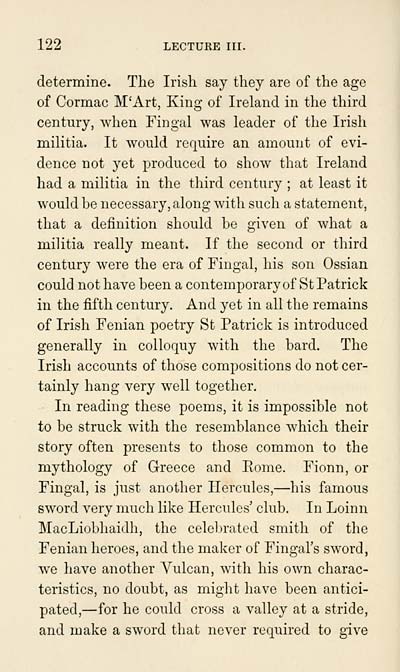Blair Collection > Celtic gleanings, or, Notices of the history and literature of the Scottish Gael
(134)
Download files
Complete book:
Individual page:
Thumbnail gallery: Grid view | List view

122 LECTURE III.
determine. The Irish say they are of the age
of Cormac M'Art, King of Ireland in the third
century, when Fin gal was leader of the Irish
militia. It would require an amount of evi-
dence not yet produced to show that Ireland
had a militia in the third century ; at least it
would be necessary, along with such a statement,
that a definition should be given of what a
militia really meant. If the second or third
century were the era of Fingal, his son Ossian
could not have been a contemporary of St Patrick
in the fifth century. And yet in all the remains
of Irish Fenian poetry St Patrick is introduced
generally in colloquy with the bard. The
Irish accounts of those compositions do not cer-
tainly hang very well together.
In reading these poems, it is impossible not
to be struck with the resemblance which their
story often presents to those common to the
mythology of Greece and Kome. Fionn, or
Fingal, is just another Hercules, — his famous
sword very much like Hercules' club. In Loinn
MacLiobhaidh, the celebrated smith of the
Fenian heroes, and the maker of Fingal's sword,
we have another Vulcan, with his own charac-
teristics, no doubt, as might have been antici-
pated, — for he could cross a valley at a stride,
and make a sword that never required to give
determine. The Irish say they are of the age
of Cormac M'Art, King of Ireland in the third
century, when Fin gal was leader of the Irish
militia. It would require an amount of evi-
dence not yet produced to show that Ireland
had a militia in the third century ; at least it
would be necessary, along with such a statement,
that a definition should be given of what a
militia really meant. If the second or third
century were the era of Fingal, his son Ossian
could not have been a contemporary of St Patrick
in the fifth century. And yet in all the remains
of Irish Fenian poetry St Patrick is introduced
generally in colloquy with the bard. The
Irish accounts of those compositions do not cer-
tainly hang very well together.
In reading these poems, it is impossible not
to be struck with the resemblance which their
story often presents to those common to the
mythology of Greece and Kome. Fionn, or
Fingal, is just another Hercules, — his famous
sword very much like Hercules' club. In Loinn
MacLiobhaidh, the celebrated smith of the
Fenian heroes, and the maker of Fingal's sword,
we have another Vulcan, with his own charac-
teristics, no doubt, as might have been antici-
pated, — for he could cross a valley at a stride,
and make a sword that never required to give
Set display mode to: Large image | Transcription
Images and transcriptions on this page, including medium image downloads, may be used under the Creative Commons Attribution 4.0 International Licence unless otherwise stated. ![]()
| Early Gaelic Book Collections > Blair Collection > Celtic gleanings, or, Notices of the history and literature of the Scottish Gael > (134) |
|---|
| Permanent URL | https://digital.nls.uk/76270218 |
|---|
| Description | A selection of books from a collection of more than 500 titles, mostly on religious and literary topics. Also includes some material dealing with other Celtic languages and societies. Collection created towards the end of the 19th century by Lady Evelyn Stewart Murray. |
|---|
| Description | Selected items from five 'Special and Named Printed Collections'. Includes books in Gaelic and other Celtic languages, works about the Gaels, their languages, literature, culture and history. |
|---|

